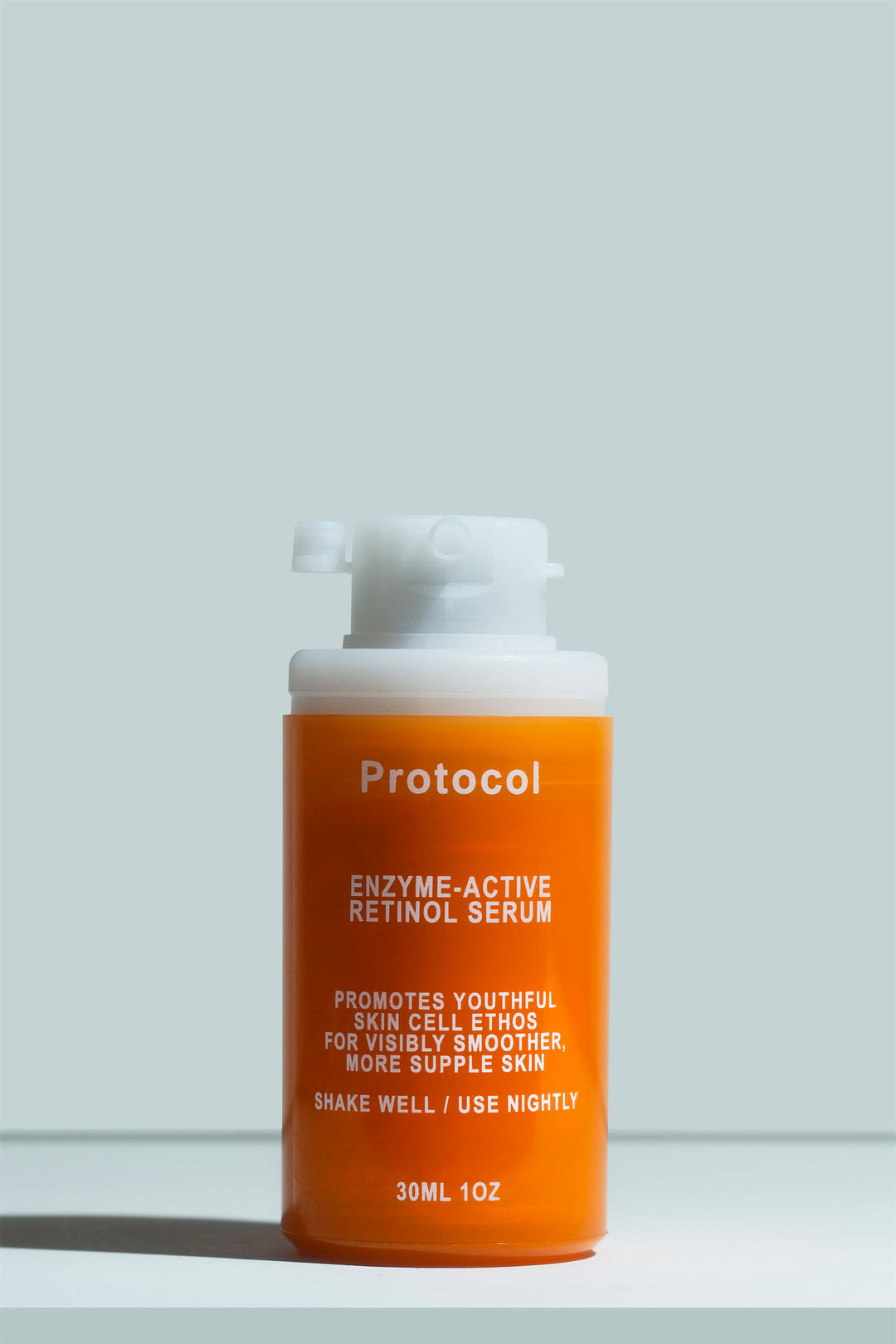Hydration Cream vs Water Lock

You may have heard that there’s a new Protocol moisturizer on the scene, designed to transform the way you combat dehydration. But this latest release, Water Lock, has also caused some confusion. How is it different from Protocol’s original moisturizer, the Hyaluronic Acid & Niacinamide Hydration Cream?
In this post, we’ll compare the two skin-nourishing powerhouses. We’ll help you figure out which one is right for you and for which situation. Let’s get into it!
Understanding the Hydration Cream
The Niacinamide & Hyaluronic Acid Hydration Cream was the first moisturizer we ever released! It’s a bouncy cream designed to boost skin functions and provide a high level of hydration for daily use. It’s the perfect nourishing touch in any skincare routine powered by real active ingredients.
Its star ingredient is niacinamide, which is skincare’s do-it-all ingredient that brightens and clarifies the skin tone, prevents premature aging, balances oily skin, and a whole lot more. There’s also hyaluronic acid to attract water to the skin and give it that plump and healthy look.
Understanding Water Lock
Then there’s Water Lock, which is our latest release: a non-greasy occlusive membrane designed specifically with one purpose in mind. The name is a hint - it locks water into the skin.
When applied to skin that’s already been saturated with water, Water Lock binds it in place and prevents evaporation, which results in maximal hydration. A small amount of it functions like a regular moisturizer, but using a little more makes it the ultimate hydrator or rescue balm.
Water Lock vs. Hydration Cream
The differences between Water Lock and Hydration Cream may not be obvious at first.
To keep it simple, we’d put it this way:
- Hydration Cream is an ideal daily moisturizer that boosts all skin functions, for long-term renewal and hydration, along with soothing, anti-aging, brightening, and clarifying effects.
- Water Lock is the ultimate emergency solution for dehydration, thanks to its ability to fully lock moisture into the skin. It’s a mild and moisturizing formula that suits all skin types and can also be used for daily hydration.
If you’d like to understand the two products in-depth, here are the differences explained factor by factor:
Main benefits
When reduced to their simplest functions, both Water Lock and Hydration Cream are moisturizers that help the skin retain water, but their benefits go beyond that.
Water Lock’s key benefit is its ability to lock water into the skin. It combats the worst dehydration and prevents transepidermal water loss to the greatest extent possible. We developed it as an alternative to Vaseline or Aquaphor - products that work similarly, but are also kind of greasy and may contribute to breakouts in some users (especially if the skin isn’t totally clean). It also seals actives into the skin, to maximize the benefits of active ingredients like retinol and vitamin C in the short term.
The Hydration Cream’s key benefits stem from its ability to improve the skin’s functions on a molecular level, thanks to niacinamide. It encourages the skin’s natural ability to retain moisture to fortify the skin barrier, soothes and calms the skin, minimizes the look of pores, offers an anti-aging effect, and overall boosts texture, tone, and clarity. It still offers plenty of moisture for daily use, but in the long term, it creates a real skin transformation.
Key ingredients
The Hydration Cream and Water Lock both contain a hybrid of essential moisturizing ingredients that work together to deliver and keep water in the skin.
The difference is that Water Lock’s balance of ingredients skews towards heavy-hitting occlusion with dimethicone, dimethicone crosspolymer, squalane, vegan beeswax, and more. Alone, these molecules are considered partial occlusives. However, when formulated together, they form an impenetrable yet flexible mesh that inhibits water loss to an incredibly high level.
The Hydration Cream’s balance of ingredients skews heavily towards renewing ingredients, and especially niacinamide. Niacinamide has a diverse range of skin benefits: It’s anti-aging, brightening, soothing, helps with oiliness, makes pores look smaller, and it encourages the skin to produce more healthy barrier lipids to stay hydrated and strong. We’ve used it at 5% - the perfect amount for science-backed results but with fewer irritation risks. The other star ingredient is hyaluronic acid, which you’re probably already familiar with. It’s a humectant that pulls water into the epidermis, for a balanced level of direct hydration.
Texture and feel
The two moisturizers feel incredibly different on the skin. Hydration Cream is a classic moisturizer - it’s bouncy, luxurious, and creamy. It feels particularly beautiful around the eye area where it sinks in readily, leaving only a hint of moist glow at the surface.
Water Lock is a little more unique, with a fluid, gel-balm texture that spreads over the skin easily as it starts to “melt”. Because of the silicones, it’s very silky and non-greasy, and it leaves the skin with a primer-like demi-matte finish.
Who it’s for
Our Hydration Cream is generally best for those with normal, combination-dry, and combination-normal skin, especially if you’re interested in seeing renewal, anti-aging effects, and improved skin tone.
You might want to skip it if you already use a high-percentage niacinamide serum or if there are already multiple products in your routine that contain niacinamide. If you have oily skin, you may also find that the Hydration Cream leaves you with more sheen then you like.
Water Lock is best for anyone with more urgent dehydration. It works beautifully for ALL skin types, from the very dry to the very oily and anyone in between. Using a larger quantity will help when your skin needs serious TLC, while a smaller amount can provide regular moisturization. Because it’s mild and inert, anyone can benefit from Water Lock.
|
Hydration Cream |
Water Lock |
|
|
The low down |
Moisture and nourishment on the molecular level |
The ultimate occlusive for thorough hydration |
|
Notable ingredients |
Niacinamide & hyaluronic acid |
Dimethicone, dimethicone crosspolymer, squalane, vegan beeswax, & hyaluronic acid |
|
Texture |
Bouncy cream |
Fluid gel-balm with a matte finish |
|
Benefits |
|
|
|
Uses |
Day or night, doubles as an eye cream |
When the skin needs extra TLC, also suitable for daily use |
|
Skin type |
Mature skin, combination-dry, combination-oily |
All skin types |
How to use Water Lock or Hydration Cream
How you use either Water Lock or the Hydration Cream can also make a difference. Here are a few routines to consider with either Water Lock or Hydration Cream, depending on how your skin feels at any given moment.
Water Lock for maximum hydration
We call this our “soak & seal” method because it’s unbeatable for eliminating dehydration as quickly as possible.
- First, saturate your skin with water. The best way to do this is by taking a bath or shower, but you can also splash your face with water for a few minutes.
- Next, apply a generous amount of Water Lock.
We recommend doing this every day while your skin is still showing signs of dehydration, and you can stop once you feel like you’re back to your normal bouncy, and glowy self. Afterward, you can just do this once in a while when you feel like your skin needs a bit of gentle TLC.
Both for maximum renewal
If your goal is to visibly transform your skin by banishing wrinkles, reducing texture, or fading discoloration, then this is the nighttime routine we’ve developed for maximum renewal.
- Cleanse and exfoliate your skin with the Double AHA Cleanser.
- Saturate your skin with water
- Apply the Enzyme Active Retinol Serum immediately - it’s our most potent skin renewer, and it’ll still help slow down moisture evaporation somewhat.
- Wait for at least a few minutes for the serum to absorb. The longer you wait, the more of the serum your skin will absorb and metabolize.
- Moisturize with the Hydration Cream. You can apply it all over, or just to target areas like around the eyes.
- Finally, apply a small amount of Water Lock all over to create that final occlusive seal.
Regular Use
Your simple nighttime or daytime routine can include the Hydration Cream, which is ideal for combination or dry skin, Water Lock which is excellent for all skin types, or neither, which is ideal if your sunscreen is moisturizing enough.
- Splash your face with water. Cleanse your skin if necessary, especially at nighttime.
- Protect your skin from free-radical damage with the Vitamin C Superserum in the daytime, or the Retinol Serum at night.
- Apply a pea-sized amount of the Hydration Cream or Water Lock and allow it to sink in completely. You can skip this step in the daytime.
- Finally, apply at least a 1/4 teaspoon of sunscreen to your face and neck if it’s daytime.
Bottom Line
While both Water Lock and the Hydration Cream are technically moisturizers, they serve different functions.
The Hydration Cream focuses on delivering long-term results, acting as a slow and steady moisturizer designed to optimize your skin's behavior. It’s meant to absorb into the skin and act on the molecular level, while Water Lock sits on top like a protective seal.
Water Lock is more of an emergency treatment, with the ability to immediately seal moisture into the skin for rapid TEWL prevention. It also functions as a regular moisturizer thanks to its mild and non-comedogenic formula that suits all skin types.
We don’t believe in having strict rules in skincare - products like Water Lock are meant to make it easier to customize and adjust your process based on what your skin needs at any given moment. There might be room in your skincare routine for both, or you may find yourself preferring one over the other. Either way, our team at the lab wishes you moist, glowy, happy skin!




